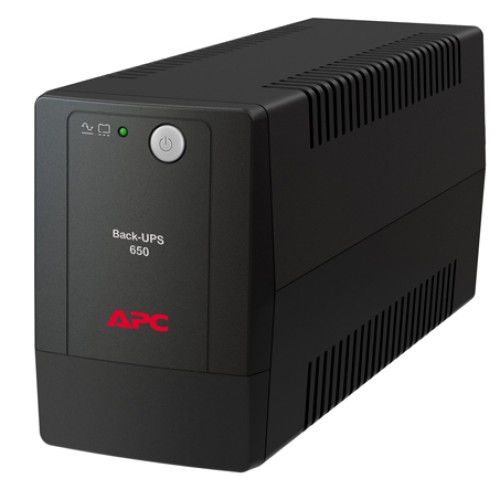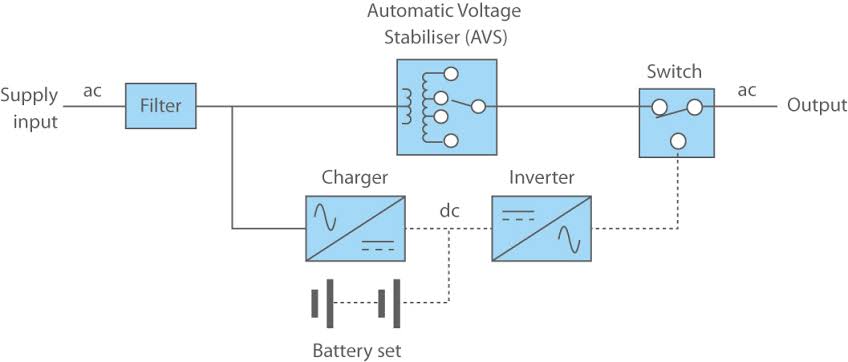What is UPS? UPS Functions? Types of UPS? How UPS Works?– Help keep your device stable, this is the understanding of UPS, UPS functions and the latest UPS working with a complete explanation.
UPS is one of the devices commonly used to back up electricity. But not only that, you also need to know the full understanding of UPS, UPS Functions and How UPS Works in the following description.
UPS Definition
UPS is an uninterruptible power supply. According to the acronym, UPS means a device that provides battery backup when the mains power does not function as usual, for example when the mains voltage is unacceptable.
UPS or an uninterruptible power supply is a device which immediately provides backup power during power failure. A UPS is normally used for computers or other devices such as networking equipments. This will allow the users to save everything to avoid data loss and properly shut the computer down.
UPS Type
Broadly speaking, UPS is divided into two, namely small UPS and larger UPS. Small UPSs can only provide power for a few minutes, while larger UPSs can provide power for several hours.
In more detail, here are the types of UPS :
- Standby UPS or Offline UPS
- Line Interactive
- Online UPS or Double Conversion
All three types will switch to the battery when the power goes out. The difference between the three types lies in how they handle in order to remain in a normal state.
The Standby UPS system will use a limited attenuation method, the Line Interactive system will use a way to smooth out bad harmonics and adjust the voltage, while the Online UPS system will continuously regenerate power.

What are the main function of UPS?
UPS is widely used by the public because it has many functions. The primary functions of UPS is to provide battery backup when the electrical power fails or drops to an unacceptable voltage level. It ensures that your electrical equipment gets a consistent current so damage, such as database corruption can be avoided.
Then what is the function of the UPS? Here are 8 functions of using a UPS:
1. Power-off Protection
When the power provided by the mains dies or is turned off, the UPS system will immediately convert the DC power in the battery into AC power to supply the load, in order to avoid inconvenience and loss caused by power failure.
2. Voltage Stabilization
Excessive or low voltage can affect the service life of the instruments and equipment used. The implementation of the UPS system can provide a stable voltage power supply for user equipment so as to ensure the normal operation of the equipment and extend its service life.
3. Surge Protection
Can protect against surges because UPS power systems are designed with point releases to absorb surges that occur, as well as to avoid surges that can affect service efficiency and equipment life.
4. High or Low Voltage Protection
When the mains voltage changes frequently, the UPS voltage regulator keeps the voltage within a safe range so as to ensure that the equipment is still operating normally. When the voltage is high or low, the UPS system will automatically start the battery power supply for continuous operation of the equipment.
5. Harmonic Distortion Protection
The existing power must be transmitted to the user through transmission and distribution lines, which causes the voltage waveform to distort and a fundamental current change occurs, resulting in harmonics being generated. The harmonics will affect the use of the equipment and the UPS system will handle it.
6. Frequency Stabilization
Frequency is defined as the period of change of a commercial power supply per second. The power frequency will usually be unstable depending on the power consumption used by the user. Then, the UPS will convert the power so that it will produce a stable frequency to ensure normal operation of the equipment.
7. Instant Protection
Pressure spikes or drops sometimes occur momentarily which can affect the accuracy of the device. Therefore, UPS is here to provide a stable voltage to protect equipment.
8. Resists Noise
The UPS protects instruments and data, ensures normal device operation and extends service life without creating excessive machine noise.
How UPS Works

Before knowing how a UPS works, you need to know what is in the UPS system. Here are the UPS components .
- Rectifier or charger : generate DC power to charge the battery or it could be to supply the inverter.
- Inverter : produces quality electrical power and is free from all utility power disturbances.
- Battery : provides sufficient backup time to ensure device safety.
- Static switch : a semiconductor device that transfers the load from the inverter to the utility then back again.
The way the UPS works varies depending on the type. In the discussion of the meaning of UPS, it has been discussed that there are 3 types of UPS whose way of working is as follows:
1. How Standby UPS or Offline UPS works
In principle, the inverter is connected in parallel with the AC input in the standby state. In normal mode operation, the load is supplied by utility power through filters that eliminate certain disturbances. The inverter operates in passive standby mode.
2. How the Line Interactive mode or type works
In principle, the inverter is connected in parallel with the AC input in the standby state, and charges the battery. In normal mode operation, the load will be supplied with conditioned power through the parallel connection of the AC input and inverter.
The inverter operates to provide voltage conditioning or charge the battery. The output frequency depends on the AC input frequency.
3. How UPS Online works
In principle, the inverter is connected in series between the AC input and the AC bypass input. In normal mode operation, all the power supplied to the load goes through the charger and inverter which simultaneously performs a double conversion like AC to DC to AC.
That was the article about the meaning of UPS, UPS functions, types of UPS and how UPS works that Matob can convey. Hope it is useful.
